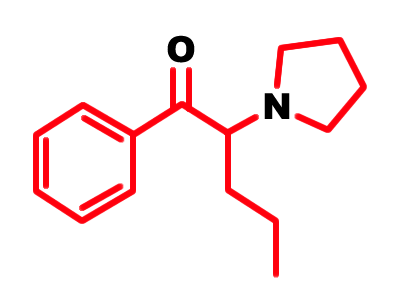Just when it seemed that the flow of synthetic drugs into the U.S. had been stemmed, a new, horrifying incident in Florida may suggest otherwise. On August 16, 2016 a 19-year-old Florida State University student and fraternity brother allegedly stabbed a married couple to death at their home and then attempted to eat one victim’s face.
Initial reports linked the double murder and subsequent cannibalism to flakka,[1] a synthetic cathinone, though new evidence potentially suggests a different type of synthetic drug. A toxicology report is currently pending. The suspected assailant, Austin Harrouff, was out to dinner with his parents at 8:30 PM on the night of the alleged murder before he became upset about the slow service and stormed out. This prompted his fraternity brothers to look for him in the neighborhood.
Harrouff happened upon the victims as they sat in their open garage, something they had been known to regularly do. He then allegedly stabbed them both to death and also stabbed a neighbor who was trying to help. When police arrived at the scene, Harrouff was found hunched over the top of one victim, “clutching him in a bear hug and biting him in the face,” according to police accounts in People magazine.
The county deputy initially shot Harrouff with a taser to no avail. Eventually, two police officers and a dog were required to subdue Harrouff, but the victim was already dead. The attack was described as “random,” and “unprovoked. Harrouff, who was initially hospitalized, will be charged with one count of aggravated battery, home invasion and two counts of murder, among other charges.[2]
Synthetic Drugs at Work?
Due to the superhuman strength police officers allege Harrouff displayed, the initial speculation was that the attack was brought on by flakka abuse. Other theories have since emerged. A police spokesman told People that they believe Harrouff drank some hazardous household chemicals from the couple’s garage.[3] Another report suggests that Harrouff was on an unidentified synthetic drug, likely from the same category as flakka or bath salts.[4]

A user’s body temperature will jump to at least 105 degrees Fahrenheit, which can lead to kidney damage, kidney failure or death. It also can elevate blood pressure, potentially leading to a heart attack, stroke, aneurysm or heart failure. Flakka initially creates euphoria, causing users to feel highly sociable and to have an increased sex drive.[7] The negative side effects become worse the more a person abuses the drug. Eventually, flakka users will begin to feel what many experts have termed “excited delirium,” which involves hallucinations, increased strength and hyperstimulation, among several other symptoms.[8]
Reminiscent of Past Zombie Drug Scare

It was initially believed that he was high on bath salts, though subsequent toxicology screenings only discovered marijuana in his system. However, with literally hundreds of chemical compounds on the streets, experts warned that there are many for which testing procedures have not been developed.
“The problem today is that there is an almost infinite number of chemical substances out there that can trigger unusual behavior,” said Dr. Bruce Goldberger, Director of Toxicology at the University of Florida, to the Associated Press. “There are many of these synthetic drugs that we currently don’t have the methodology to test on, and that is not the fault of the toxicology lab. The challenge today for the toxicology lab is to stay on top of these new chemicals and develop methodologies for them, but it’s very difficult and very expensive. There is no one test or combination of tests that can detect every possible substance out there.”[9]
The Dangers of Synthetic Drugs
While all drugs are dangerous, synthetic or designer drugs have an added element of danger in that there is no way of truly knowing which chemicals were used to create them. Drugs like cocaine, heroin and marijuana are all derived from plants. There is nothing natural about synthetic drugs. They are made using all sorts of chemicals, including gasoline and paint thinner to name a few.
A hit of flakka can be bought for as little as $3 online. Additionally, the high availability and low cost make synthetic drugs even more dangerous for younger people, who may not have money for or access to non-synthetics. A hit of flakka can be bought for as little as $3 online, whereas a gram of cocaine can cost as much as 25 times that price.[10] A college or high school student or others with low income could be lured into using synthetic drugs in an attempt to get high while spending less money.
Another problem is that users of synthetic drugs are often duped into believing they are getting high legally. For a short while, this was actually true, but the U.S. Drug Enforcement Administration (DEA) placed a temporary ban on flakka and nine other synthetic cathinones in 2014,[11] while 2012 legislation signed by President Barrack Obama also placed a ban on synthetic drugs.[12] However, the illegality of these synthetic drugs are constantly being circumvented by rogue chemists who make slight adjustments to their drug formulas.
Learn More About Use and Abuse of Synthetic Drugs
Whether discussing synthetic cathinones, opioids or cannabinoids, many addiction rehab facilities are dreadfully unknowledgeable and ill-equipped to deal with problematic usage or addiction. At Seaside Palm Beach, we are fully versed in all of the expert literature and studies available on this class of drugs. Additionally, we also conduct our own in-house research to learn more about how these drugs work and the most effective recovery strategies.
There is no acceptable amount of usage for synthetic drugs. If you or someone you care for has fallen into a habit of constant use and abuse, it will likely end badly. Be proactive rather than reactive, and contact our addiction experts today at 888-997-3274 to learn about your treatment options.
[1] https://www.washingtonpost.com/news/post-nation/wp/2016/08/16/fsu-student-tried-bite-off-victims-face-in-brutal-double-homicide-police-say/?utm_term=.20250a9fe9e7
[2] http://www.people.com/article/FSU-frat-brother-flakka-charged-eating-man-s-face
[3] http://www.people.com/article/fsu-student-who-allegedly-tried-to-eat-mans-face-drank-chemicals-he-found-in-victims-garage
[4] http://www.foxnews.com/health/2016/08/29/use-zombie-drug-flakka-appears-to-be-declining-in-florida-feds-say.html
[5] http://www.drugpolicy.org/blog/trending-now-flakka-gravel-alpha-pvp-and-what-you-need-know
[6] https://www.drugabuse.gov/publications/drugfacts/synthetic-cathinones-bath-salts#textbox2
[7] http://www.mayoclinic.org/diseases-conditions/high-blood-pressure/basics/complications/con-20019580
[8] http://www.fmhac.net/assets/documents/2012/presentations/krelsteinexciteddelirium.pdf
[9] http://www.cbsnews.com/news/rudy-eugenes-toxicology-report-experts-speculate-on-what-caused-face-chewing-attack/
[10] https://www.globaldrugsurvey.com/the-global-drug-survey-2015-findings/
[11] http://www.deadiversion.usdoj.gov/fed_regs/rules/2014/fr0307_2.htm
12] https://www.whitehouse.gov/ondcp/ondcp-fact-sheets/synthetic-drugs-k2-spice-bath-salts




